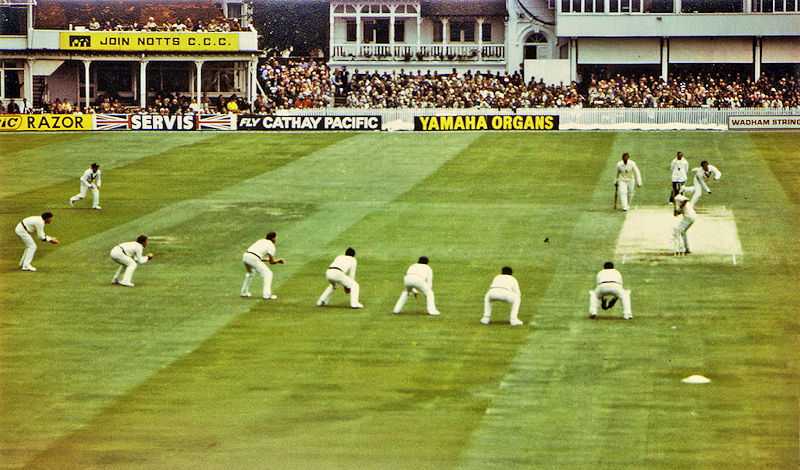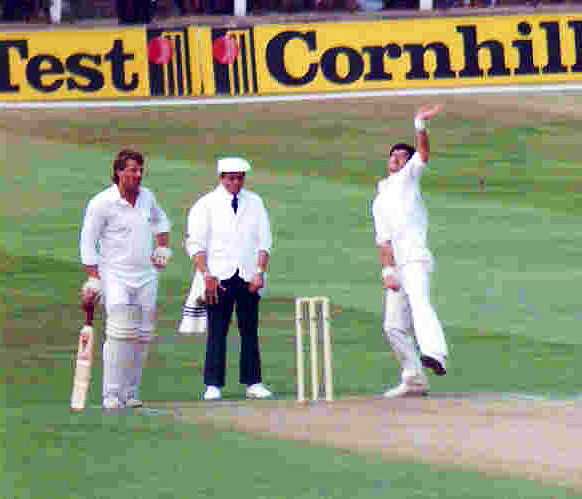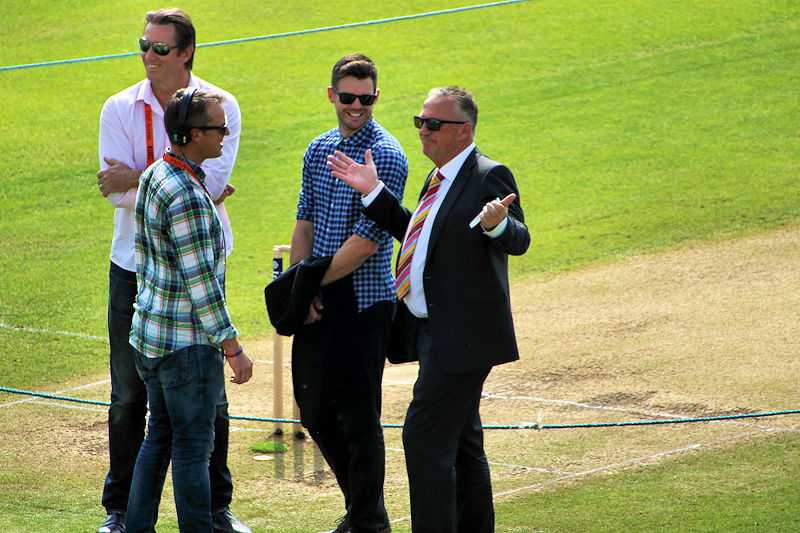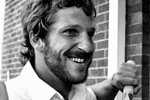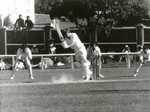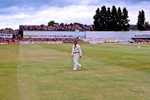1. Botham's early life
Ian Terence Botham was born in November 1955 in Heswall on the Wirral, Merseyside.
Both his parents, Herbert and Violet, played cricket, helping to introduce their son to the sport at any early age. Botham was still young when he moved toYeovil, beginning a long association with the county of Somerset.
School
Botham looked to get involved in any cricket games being played near his home as well as playing for his school. His performances at school level started to draw attention and he was invited to play for Somerset under 15s, scoring an impressive 80 on his debut while still only 13 years old.
At this time Botham had the option to try and pursue a career in football and although offered a contract by Crystal Palace a couple of years later, he chose to stick with cricket, a decision thousands of English cricket fans would later come to appreciate.
MCC Groundstaff
After leaving school Botham joined the ground staff at Lords while he looked to earn a full-time professional contract with Somerset.
In his time at Lords he played occasionally for the MCC as well as Somerset under 25’s, and although still young at this stage of his career he did not initially show the promise which would make him one of the most feared and respected all-rounders in the game. Indeed he was often viewed as a specialist batsman only, with his bowling overlooked.
It was in his second year at Lords in 1973 when his form began to improve for the Somerset under 25’s and he moved up to represent the county’s second eleven.
2. Botham's early career
After playing for the Somerset second eleven, Botham was to experience a taste of the first team in 1973 - when aged 17 he featured in a couple of one day games.
The following season in 1974 the future test all-rounder made his first class debut for Somerset, playing against Lancashire at Taunton.
Losing four teeth
Botham was to show his promise throughout the season and he was also to show his grit and determination.
Batting at 9 in the quarter-final of the B&H one day cup Botham attempted a hook against the rapid West Indian international Andy Roberts. The ball struck Botham in the face and he would lose 4 of his teeth. Yet the 18 year-old Botham carried on batting and helped his side to a famous victory, being named Man of the Match.
Botham was headline news, something that would happen time and again.
England call up
Botham did not have to wait too long for his first taste of international cricket, playing against the West Indies in a one day game in 1976.
Interesting fact...
Botham's international debut was not particularly successful. England lost by six wickets, and Botham scored only 1 with the bat. At least he took his first international wicket, that of Lawrence Rowe, as he returned 26 for 1 in three overs.
Botham had already notched his maiden first class century against Nottinghamshire earlier that season and his good form continued in to 1977 when he received his call up to the England test squad.
He made his debut in the third test match against Australia at Trent Bridge in Nottingham, with England already one up in the series. He made an immediate impact with the ball, taking five wickets in the first innings including the Australian captain Greg Chappell. His performance was enough to secure another start in the fourth test where his bowling did the damage again.
Unfortunately this was not the only damage done as he broke a bone in his foot treading on the ball in the outfield, forcing an abrupt end to his season.
Test career
Botham’s illustrious career, in which he played 102 test matches, saw him race to 100 test wickets in just his 19th appearance, the fifth quickest to reach the landmark at that time.
He was an important member of the one day team which reached the final of the World Cup in 1979, where they lost to the West Indies at Lords, in large part to an innings of 134 from Botham’s good friend Viv Richards.
He also had been dominant that year in the Test series against India before continuing in this vain in the one-off Golden Jubilee test match against the same opponents in 1980. Here the all-rounder became the first player to score a century and take ten wickets in the same test match.
Captain Beefy
It was following the Golden Jubilee test when Ian Botham was appointed captain in the wake of Mike Brearley's resignation. The challenge ahead was a series against the West Indies, the leading side in world cricket at that time. West Indies won the series 1-0, but the English summer was badly affected by rain - otherwise the margin of defeat may well have been heavier.
Botham also struggled for form in the series, failing to have the impact fans had become accustomed to.
3. Headingley 1981
Headingley 1981 is a place and date etched in to English cricketing folklore. However the build up to this day was anything but smooth for Ian Botham.
After a further series defeat to the West Indies on tour, a home Ashes series beckoned amid grumblings about Botham’s captaincy style. After the first two tests Australia held a 1-0 lead and Botham’s form had completely deserted him, out without scoring in both innings of the second test.
He duly resigned and Mike Brearley was re-appointed captain for the third test at Headingley.
While Botham re-found his form it seemed Australia would still be too strong, forcing England to follow-on. At 135-7 in the second innings and defeat looking inevitable up stepped Botham to smash a swashbuckling 149 not out, ably supported by Graham Dilley and Chris Old.
Interesting fact...
Headingley in 1981 was only the second time that a team had won a test match after following on!
The target for the Australians was still only 130, but an inspired spell of fast bowling from Bob Willis sealed a remarkable victory. England went on to win the final two tests and the series aided by a rejuvenated and inspired Botham, who during one spell of bowling in the fourth test took 5 wickets for just one run.
Unsurprisingly he was named man of the series, scoring 399 runs and taking 34 wickets. An often forgotten part of Botham’s game was his safe pair of hands, particularly as a slip fielder, and in this series alone he took 12 catches.
He was also voted BBC Sports Personality of the year for 1981.
4. Botham's Later Career
It would be hard to better Headingley in 1981. But Botham's later career was hardly a disappointment.
The highlight of later years was the 1991 World Cup, in which England were beaten in the final by Pakistan. Botham had a good tournament, winning two man of the match awards, though he couldn't emulate his previous success in the final (returning match figures of 1 for 42 off 7 overs, and being out for a duck).
Worcestershire and Durham
Botham eventually left his beloved Somerset in 1986 in protest at the sacking of fellow players Viv Richards and Joel Garner, before playing for Worcestershire for five seasons and Durham for two, retiring in 1993.
He also had a spell playing for Queensland in Australia.
Statistics and records
When he hung up his boots in the middle of the 1993 season, Botham great statistics and records to reflect on:
- Botham's haul of 383 test wickets made him at that stage the second highest wicket taker of all time. Botham remained the top English wicket taker until he was surpassed by James Anderson in 2015. His wickets came at a very respectable average of 28.40, with 27 five-wicket hauls and 4 ten-wicket matches.
- Botham's test batting netted him 5,200 runs, at an average of 33.54, including 22 fifties and 14 hundreds. His top score of 208 was reached against India in 1982.
- Botham was the first player to take 10 wickets and score a hundred in a test match, against India in Mumbai in 1980. Only two other players have since managed that feat.
But Botham's stats do not tell the story of what an impact player he was. Botham rose to the occasion and could take a match by the scruff of the neck, single-handedly turning it around in a completely thrilling manner.
Interesting fact...
Botham's figures are respectable but not earth-shattering. But when you focus on the first 25 tests of Botham's career, his bowling average is a world-class 18.52 and his batting average 40.48 (see Andy Zaltzman's excellent [blog](https://www.thecricketmonthly.com/story/1057899/the-best-stats-measure)). Botham's quality in the early years of his career is further demonstrated that he was man of match for three of the six ashes tests of 1981.
5. Charity Work and Legacy
Botham continued to play international cricket until 1992.
He could still influence tournaments, taking 16 wickets in 10 games as England reached the 1992 World Cup Final in Australia.
John O'Groats to Land's End
When he broke his toe back in the Ashes series of 1977 he could not have envisaged where that may end up taking him. While in hospital he wondered in to the children’s ward and saw patients who had leukaemia with only weeks to live.
It was a powerfully sobering moment for Botham, one which saw him take on a number of high-profile walks to raise funds for the cause. This series of gruelling walks began with John O’Groats to Land End in 1985, an 874 mile effort which raised £400,000.
Other walks took Botham to Sri Lanka, South Africa and Australia and it was in recognition of his charitable endeavours as well as his cricketing achievements that he was awarded a Knighthood in 2007.
Commentary
Botham continues in cricket as a commentator, offering considered but forthright insights in to the game today. He has had his controversies, such as when he was banned for two months in 1986 after admitting to using cannabis, but Botham was a big personality as well as a big hitter on and off the cricket field.
English cricket has struggled to find an all-rounder to match Botham’s pedigree since.
